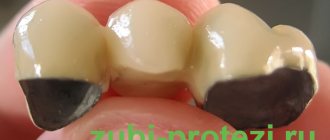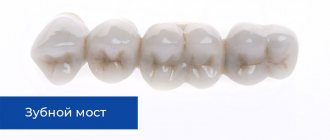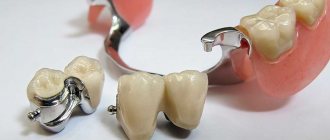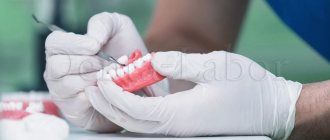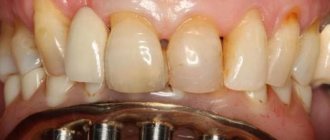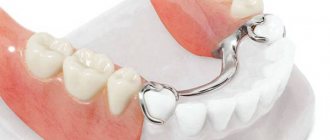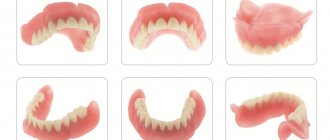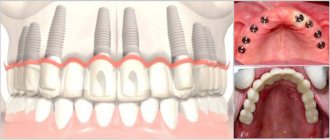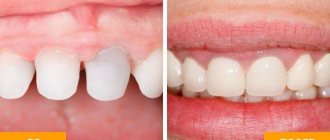Chief editor of the site:
Snitkovsky Arkady Alexandrovich
Chief physician of the professorial dentistry “22 Century”, dentist, orthopedic dentist
Author of the article:
Scientific team of dentistry “22 Century”
Dentists, candidates and doctors of medical sciences, professors
Adhesive prosthetics allows you to restore a lost tooth with minimal grinding of neighboring ones. This gentle technique does not require preparation on all sides (as with traditional bridges) and is successfully used in the 22nd Century dental clinic. It is especially suitable for those who believe that their own enamel is always better than artificial material.
Key Features
An adhesive bridge is made of artificial material and is fixed to adjacent teeth, without preliminary grinding, which is required in most other methods. The latches are located on the inside of the supports, which act as adjacent units, so the product remains invisible. A high degree of aesthetics is ensured by the reliable appearance of the material, imitating natural enamel.
Due to the insufficient stability of the structure and the installation method, no more than three teeth can be installed. This is an excellent solution for installing missing anterior units in the visible smile area. An adhesive bridge is not suitable for the chewing area, since the retainers may not cope with the full chewing load.
Alternative methods of restoring dentition
Despite the benefits that adhesive dental restoration offers, there are many worthy treatments available. For example, installing a classic bridge is already considered a true classic of prosthetics - dentists have been practicing this procedure for more than 30 years. Compared to adhesive prosthetics, a bridge can replace up to four teeth in a row instead of three. Another significant advantage of a bridge prosthesis is the possibility of installation in the chewing area.
Implantation is good because it is excellent for restoring teeth with any defects - even complete edentia can be eliminated by installing implants.
Operation sequence
- Initial examination of the patient and collection of anamnesis. A diagnosis is made and a detailed treatment plan is drawn up;
- Carrying out diagnostics using electroodontodiagnostics;
- Preparation of the oral cavity. Processing is carried out using special tools that improve the contact of enamel and composite;
- After taking the impressions, a working structure is made and covered with colored wax;
- The surface of the teeth undergoes medicinal treatment. After applying the composite, its excess is removed;
- Polymerization with a special light flux;
- Final adjustment and polishing.
Video illustration of the process of adhesive dental prosthetics without drilling
FAQ
— Why are adhesive prostheses called miracle prostheses?
Adhesive prosthetics are truly considered an innovative approach in dentistry. They are also called "sticky". They require minimal turning, but that is not why they are called “miracles”. The fact is that this method of restoring the dentition allows you to return a healthy smile in just one visit to a specialist. The patient gets excellent results for little money.
— What to do if food restrictions affect your usual diet?
The requirements after the installation of dentures relate only to the structure of the food itself. In order to enjoy apples or carrots, it is enough to cut or grate them, and chop whole nuts.
Main indications
- An adhesive denture is used to treat 1-2 teeth in the visible smile area to restore a healthy appearance;
- Performed on patients with poor health for whom other methods are contraindicated;
- For people with cardiovascular diseases or after a heart attack.
Contraindications include:
- Adhesive dental prosthetics is impossible without a sufficient number of supports;
- Not suitable for solving significant defects;
- Bruxism;
- Not carried out in case of pathological abrasion of enamel;
- Malocclusions may interfere with the placement of an adhesive restoration.
Care instructions
In order for the product to last a long time, compliance with the rules and recommendations for care is mandatory. These include:
- mandatory brushing of teeth at least twice a day;
- regularly rinse your mouth after breakfast, lunch and dinner using mouth rinses;
- using dental floss to better clean the area where the prosthesis is installed;
- Visit your doctor once or twice a year for professional dental cleanings.
In addition to care measures, it is important to avoid too hard foods; you should also not open bottles with your teeth or crack nuts - all this will end in breakage of the product.
Positive sides
As soon as this method began to be practiced in dentistry, a large number of patients actively began to become interested and give preference to this method of dental restoration. The popularity is due to the following factors:
- Affordable price.
- Very fast result.
- Preservation of healthy teeth unchanged.
- This denture looks very neat in the mouth.
- At the right time, it can be easily removed in the dentist’s office.
- You can restore two teeth at once.
- No complex equipment required.
Life time
The relatively low strength of composite materials determines the comparative fragility of the adhesive prosthesis. On average, it will last about five years, with careful handling - a maximum of 10-12. The service life directly depends on how strictly the patient adheres to the recommendations of the attending physician. To prolong the life of the adhesive bridge, you should avoid hard foods and do not put stress on your teeth. It is necessary to systematically brush your teeth using floss and various rinses. The main task is to prevent the occurrence of secondary caries, which can lead to loss of supporting teeth.
Recommendations for installation and possible contraindications
This method of prosthetics is not suitable for all patients. A specialist will be able to carry out the procedure only if there are minor defects. In cases with the absence of one premolar, canine or incisor. Exceptions are the absence of two incisors, but of small sizes. Sanitation of adjacent teeth is also a prerequisite. They may be healthy but have structural defects.
Main indications:
- the patient has absolute contraindications to other types of prosthetics and implantation;
- if for some reason the main prosthetics is postponed, this procedure is a temporary solution to the problem;
- it is required to create a cosmetic effect in the shortest possible time.
Relative and absolute contraindications include:
- significant defect in the dentition with the absence of more than 2 units;
- the supposed supporting units have diseases in the form of extensive carious lesions or periodontal disease, and are also characterized by significant mobility and abnormal development;
- Acute inflammatory processes on the mucous membrane were detected in the oral cavity.
Important: Specialists often refuse to install an adhesive dental bridge if there are already installed ceramic or metal-ceramic structures on the opposing dental units. In such cases, prosthetics will not be effective.
Types of fastenings
Installation can be done in three ways:
- Fastening on beams . This type of fastening is used to increase the stability of the structure. The beam is made of wire and is fixed using a special composite.
- Splinting. During this fixation method, a special fiberglass tape is used. She's comfortable
Bridge splintingplaced in the area of the supporting teeth. In order to ensure reliable fastening, you just need to apply the tape correctly.
- Application of a design without turning . During this fixation method, the support is processed and the prosthesis is secured on the sides. Adhesive materials can also be used for fastening. To do this, strips of fiberglass or plastic are glued on the back side, which will subsequently hold the entire row of teeth.
Advantages and disadvantages of adhesive dental prosthetics
Adhesive dental prosthetics has certain advantages:
- The ability to quickly restore the integrity of the dentition.
- Ease of manufacture.
- Minimal impact on supporting teeth.
- Painless installation procedure.
- Low cost. Prices for adhesive bridges are much lower than for other types of dental restoration.
- Possibility of replacement without damaging adjacent teeth.
- High aesthetics. When ceramic or composite materials are used, artificial crowns look like real teeth because the shade of the adhesive bridge is matched to the color of the patient's natural enamel.
With all the advantages, this technique also has disadvantages:
- Low strength and short service life of the orthopedic structure. With gentle use and regular care, the prosthesis will last up to three years. Therefore, this type of prosthetics is used as temporary.
- Incomplete restoration of a lost tooth. Adhesive bridges eliminate a cosmetic defect, but do not restore the function of the tooth, since they are not suitable for heavy loads.
- Atrophy of the jaw bone at the site of the defect. This process is caused by a lack of load and subsequently leads to sagging of the bridge.
- Quick loss of attractive appearance. Composite materials used in adhesive dental prosthetics fade in a short time, and after about a year of use, scratches and chips appear on them.
Comments
I’m 50 years old, the doctor recommended that I have my front tooth removed - it put me at a dead end, I wasn’t ready, and I don’t have much money right now. I was very worried that I would have to install a regular bridge. Now, thanks to your article, I know that there is an inexpensive alternative - an adhesive bridge. But my question is, how long will it last me?
Taranova G.L. (09/06/2019 at 09:03) Reply to comment
- It makes sense to consider an adhesive bridge as a very short-lived or temporary solution. Its actual service life is 1-3 years. Due to its fragility, such a structure often breaks in the fixation zone, cracks appear on it - this happens because most patients during operation forget that the bridge should not be subjected to a strong chewing load and try to chew solid food. But as an inexpensive temporary solution after a front tooth extraction, it is a good option. The main thing is to decide during its operation what to do next, consider other, more durable options for prosthetics or implantation.
Editorial staff of the portal UltraSmile.ru (08/09/2019 at 08:55) Reply to comment
Write your comment Cancel reply
Beam construction for greater strength.
The adhesive beam prosthesis is famous for its greatest strength. Its design uses a wire beam fixed in the recesses of the supporting teeth. Often these are depressions of a natural nature - cavities usually occupied by fillings in the teeth next to the lost one. Extensive fillings in such teeth are not uncommon. The doctor removes the filling material and obtains ideal cavities for the installation of the beam. The beam acts not only as a fastening element, but also performs a reinforcing function. Such a bar adhesive prosthesis is much more reliable and durable than a classic adhesive prosthesis, but still, it should not be used to restore chewing teeth. The load on the teeth in the masticatory region is so great that there is a high risk of damage to the adhesive prosthesis. As negative aspects that arise when installing such a prosthesis, it is worth mentioning the likelihood of developing periodontitis and pulpitis in the supporting teeth. In addition, access to these teeth becomes more difficult, as a result of which their endodontic (preservation) treatment may be difficult.
Contraindications
Based on the above, it is not difficult to guess what limitations apply to this technique:
- Many teeth are missing. Or the following situation occurs: 2 teeth are lost. But they are not located next to each other.
- The condition of other units is unsatisfactory; they cannot serve as a reliable support.
- Diseases of the oral cavity in the acute stage.
After an in-person visit to the dental office, the doctor will tell you whether you can have a bridge placed without preliminary grinding.
When is an adhesive bridge used?
In orthopedic dentistry, an adhesive bridge, to restore the integrity of the dentition, is used in the following clinical situations:
- in the absence of ONE tooth (premolar or incisor) in the upper or lower jaw
- during implantation or bone grafting in the frontal part of the dentition, as a temporary structure
- as a temporary bridge, before making a permanent bridge
- with stable and living supporting teeth, in order to preserve the dental nerve from depulpation, and in order to avoid grinding.
Fact #4: Wearing bridges can cause tooth decay.
When installing a bridge, the dentist glues its wings to the surface and ledges made in the supporting teeth. The design itself seems simple, but caring for teeth in the area where the plates are located is not so easy. If the plates are not glued very well, then pieces of food and bacteria can get clogged under them, which will provoke inflammation and cause the development of caries.
“I wore such a bridge, I can say that at first it really seems quite beautiful, and its price is even more pleasing, and plus there is no need to depulpate the teeth. BUT, after 1-2 years the beauty of the smile deteriorates sharply, it seems that the bridge is not adjacent to the gum, but is simply dangling in the air, i.e. a distance appears between it and the gum. And this is inevitable, the doctor told me that it is bone atrophy that leads to this effect. Only an implant will save you from atrophy. And girls, in the end I spent 8 thousand on the bridge, and then 30 thousand on the implant. Now I understand that these bridges do not even delay the costs of treatment, but only increase them even more!”
Margot, review from otzovik.com
A patient who wears an adhesive device needs to improve oral hygiene and purchase an irrigator in order to efficiently remove the smallest food debris and plaque. You also need to visit the dentist twice a year to assess the condition of the supporting units and to check the quality of the bridge fastening. As practice shows, in some patients this type of construction partially or completely comes off during use, which causes some discomfort and forces you to constantly be on edge.
Notice
: Undefined variable: post_id in
/home/c/ch75405/public_html/wp-content/themes/UltraSmile/single-item.php
on line
45 Notice
: Undefined variable: full in
/home/c/ch75405/public_html/wp-content /themes/UltraSmile/single-item.php
on line
46
Rate this article:
( 3 ratings, average: 5.00 out of 5)
prosthetics
- Lutskaya I.K. Prospects for adhesive prosthetics in therapeutic dentistry. Modern dentistry, 2011.
Expert “Adhesive structures have a right to exist. They really help out those patients who are not yet ready to financially invest in a longer-term prosthetic option, but still want to restore the aesthetics of their smile. However, if you are choosing between types of adhesive bridges, then choose those that are made of higher quality materials: ceramics, zirconium dioxide. Products made from composites quickly lose their aesthetics; difficult-to-remove bacterial deposits, odors, and dyes accumulate on them; they do not recreate the shine of natural enamel and require constant polishing. However, here again you need to evaluate how long the prosthesis is installed.” Therapist, surgeon, orthopedist Vladislav Olegovich Vataev
Consulting specialist
Vagapov Zakir Irkinovich
Doctor rating: 7 out of 10 (3) Specialization: Orthodontist Experience: 15 years
